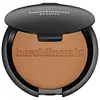What's inside
What's inside
 Key Ingredients
Key Ingredients

 Benefits
Benefits

 Concerns
Concerns

 Ingredients Side-by-side
Ingredients Side-by-side

Mica
Cosmetic ColorantOctyldodecyl Stearoyl Stearate
EmollientSilica
AbrasiveBoron Nitride
AbsorbentLauroyl Lysine
Skin ConditioningMagnesium Myristate
Caprylic/Capric Triglyceride
MaskingBis-Stearyl Dimethicone
EmollientWater
Skin ConditioningErythrulose
TanningPalmitoyl Isoleucine
Skin ProtectingIsochrysis Galbana Extract
Skin ConditioningPolyglyceryl-2 Triisostearate
EmulsifyingPtfe
Polyethylene
AbrasivePhenoxyethanol
PreservativeTitanium Dioxide
Cosmetic ColorantIron Oxides
CI 77163
Cosmetic ColorantMica, Octyldodecyl Stearoyl Stearate, Silica, Boron Nitride, Lauroyl Lysine, Magnesium Myristate, Caprylic/Capric Triglyceride, Bis-Stearyl Dimethicone, Water, Erythrulose, Palmitoyl Isoleucine, Isochrysis Galbana Extract, Polyglyceryl-2 Triisostearate, Ptfe, Polyethylene, Phenoxyethanol, Titanium Dioxide, Iron Oxides, CI 77163
Mica
Cosmetic ColorantDimethicone
EmollientSynthetic Wax
AbrasiveCaprylic/Capric Triglyceride
MaskingBoron Nitride
AbsorbentPtfe
Kaolin
AbrasiveSodium Dehydroacetate
PreservativeIsoeicosane
EmollientPolyethylene
AbrasiveSilica
AbrasiveHydrogenated Lecithin
EmulsifyingCI 77891
Cosmetic ColorantCI 77163
Cosmetic ColorantIron Oxides
CI 75470
Cosmetic ColorantCI 77742
Cosmetic ColorantCI 15850
Cosmetic ColorantIngredients Explained
These ingredients are found in both products.
Ingredients higher up in an ingredient list are typically present in a larger amount.
Boron Nitride is compound consisting of boron and nitrogen. It is used to absorb oil and modify adherence/ slip in products.
This means it is often used in makeup products to help them last longer.
This ingredient is an emollient, solvent, and texture enhancer. It is considered a skin-softener by helping the skin prevent moisture loss.
It helps thicken a product's formula and makes it easier to spread by dissolving clumping compounds.
Caprylic Triglyceride is made by combining glycerin with coconut oil, forming a clear liquid.
While there is an assumption Caprylic Triglyceride can clog pores due to it being derived from coconut oil, there is no research supporting this.
Learn more about Caprylic/Capric TriglycerideThis synthetic powder is used to add a pearly/white color in cosmetics.
Mica is a naturally occurring mineral used to add shimmer and color in cosmetics. It can also help improve the texture of a product or give it an opaque, white/silver color.
Serecite is the name for very fine but ragged grains of mica.
This ingredient is often coated with metal oxides like titanium dioxide. Trace amounts of heavy metals may be found in mica, but these metals are not harmful in our personal products.
Mica has been used since prehistoric times throughout the world. Ancient Egyptian, Indian, Greek, Roman, Aztec, and Chinese civilizations have used mica.
Learn more about MicaPolyethylene is a synthetic ingredient that helps the skin retain moisture. It is a polymer.
It is also typically used within product formulations to help bind solid ingredients together and thicken oil-based ingredients. When added to balms and emulsions, it helps increase the melting point temperature.
PTFE is a form of PFAS, or "Per- and polyfluoroalkyl substances". This ingredient has been used in commercial applications since the 1940's.
In cosmetics, PTFE is most commonly used as bulking agents, to improve consistency, or to improve texture.
PFAS compounds are currently under scrutiny due to possible health risks. This is mostly due to one type of PFAS: PFOA.
PFOA is no longer used in cosmetics and is highly restricted in many countries.
Today, PFAS are used widely in the medical field. They often play an important role in medical equipment such as catheters and medical implants.
In 2018, the Expert Panel for Cosmetic Ingredient Safety found PTFE to be safe for use in cosmetics and personal care productions.
This ingredient is commonly found in mascara (up to 13%) and hair bleach (up to 2.4%). Studies show this ingredient does not cause skin or eye irritation.
The EU allows PTFE to be used in cosmetics without restrictions.
All federal agencies do state further research about PFAS in cosmetics is needed.
Whether you choose to use this ingredient is a personal choice. We recommend adding this ingredient to your liked or disliked list so you can be notified anytime a product contains this ingredient.
Learn more about PtfeSilica, also known as silicon dioxide, is a naturally occurring mineral. It is used as a fine, spherical, and porous powder in cosmetics.
Though it has exfoliant properties, the function of silica varies depending on the product.
The unique structure of silica enhances the spreadability and adds smoothness, making it a great texture enhancer.
It is also used as an active carrier, emulsifier, and mattifier due to its ability to absorb excess oil.
In some products, tiny microneedles called spicules are made from silica or hydrolyzed sponge. When you rub them in, they lightly polish away dead skin layers and enhance the penetration of active ingredients.
Learn more about SilicaThis ingredient is a combination of red, black, and yellow iron oxide pigments. This combination of colors is usually found in foundation, because it results in a "skin" color.